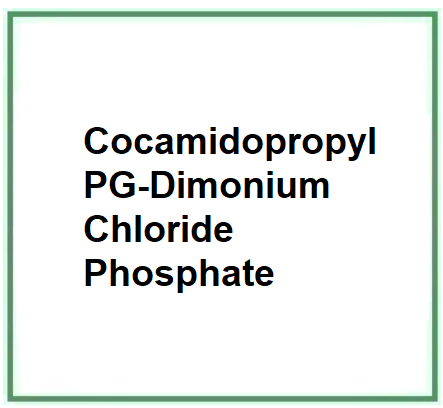Cocamidopropyl PG-Dimonium Chloride Phosphate is a chemical compound derived from fatty acids present in coconut oil and contains an amide structure, propylene glycol groups, ammonium groups, and chloride and phosphate ions.
The name describes the structure of the molecule:
- Cocamidopropyl indicates that the molecule is derived from fatty acids of coconut oil and has an amide structure attached to a propyl group.
- PG-Dimonium indicates the presence of a propylene glycol group (PG) and the presence of two ammonium groups (dimonium).
- Chloride Phosphate indicates that the molecule contains both chloride ions and phosphate ions.
Description of the raw materials used in production and their functions:
- Coconut Oil. Provides the fatty acids used to produce the "coco" portion of the surfactant.
- 3-Chloropropane-1,2-diol (or Propylene Glycol Chlorohydrin). Provides the "propyl" and "PG" part of the name.
- Phosphate. Used to produce the "phosphate" portion of the salt.
Step-by-step industrial synthesis:
- Fatty acids derived from coconut oil are converted into amides through reaction with amine.
- The amides are subsequently quaternized with 3-chloropropane-1,2-diol to produce cocamidopropyl PG-dimonium chloride.
- The chloride is then neutralized with a phosphate source to produce the salt, cocamidopropyl PG-dimonium chloride phosphate.
Cocamidopropyl PG-Dimonium Chloride Phosphate is typically found as a liquid ingredient in cosmetic and personal care formulations and it usually appears as a clear to slightly yellowish liquid.

What it is for and where
Cosmetics
Antistatic agent. Static electricity build-up has a direct influence on products and causes electrostatic adsorption. The antistatic ingredient reduces static build-up and surface resistivity on the surface of the skin and hair.
Hair conditioning agent. A significant number of ingredients with specific and targeted purposes may co-exist in hair shampoo formulations: cleansers, conditioners, thickeners, matting agents, sequestering agents, fragrances, preservatives, special additives. However, the indispensable ingredients are the cleansers and conditioners as they are necessary and sufficient for hair cleansing and manageability. The others act as commercial and non-essential auxiliaries such as: appearance, fragrance, colouring, etc. Hair conditioning agents have the task of increasing shine, manageability and volume, and reducing static electricity, especially after treatments such as colouring, ironing, waving, drying and brushing. They are, in practice, dispersants that may contain cationic surfactants, thickeners, emollients, polymers. The typology of hair conditioning agents includes: intensive conditioners, instant conditioners, thickening conditioners, drying conditioners. They can perform their task generally accompanied by other different ingredients.
Commercial Applications
Cosmetics and Personal Care Products. This compound is commonly used as a conditioning agent for hair and skin, enhancing the feel of the products. It can be found in shampoos, conditioners, lotions, and creams.
![]() Cocamidopropyl PG-Dimonium Chloride Phosphate
Cocamidopropyl PG-Dimonium Chloride Phosphate 


